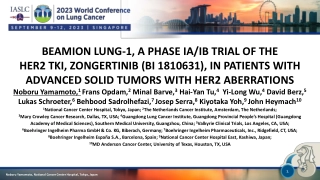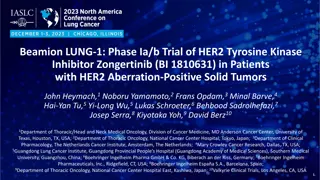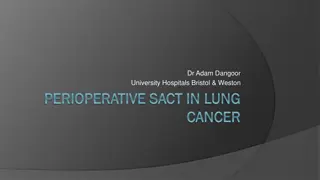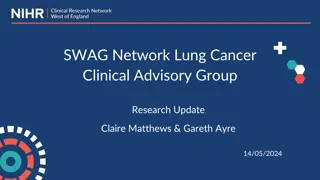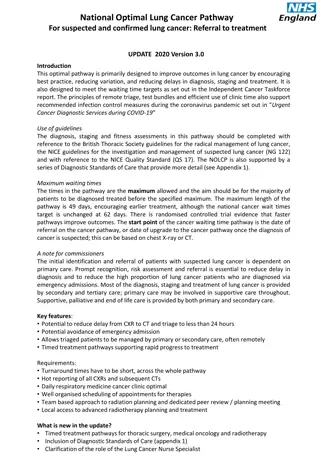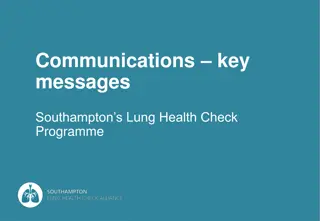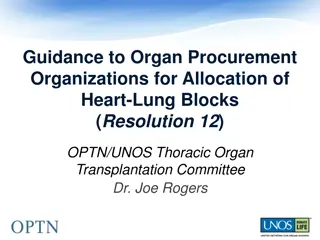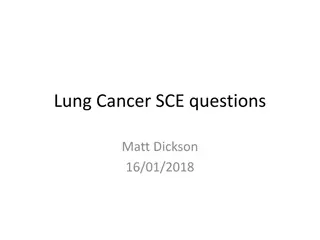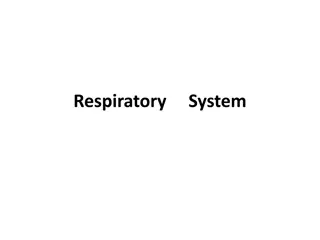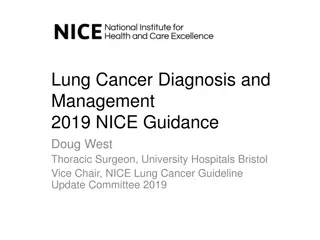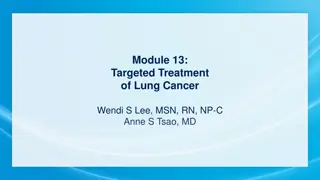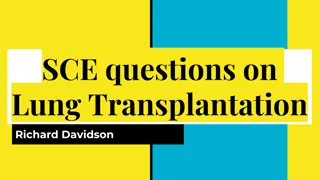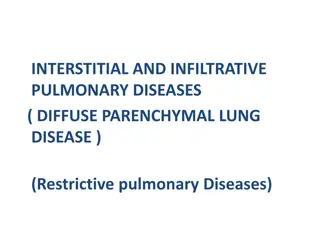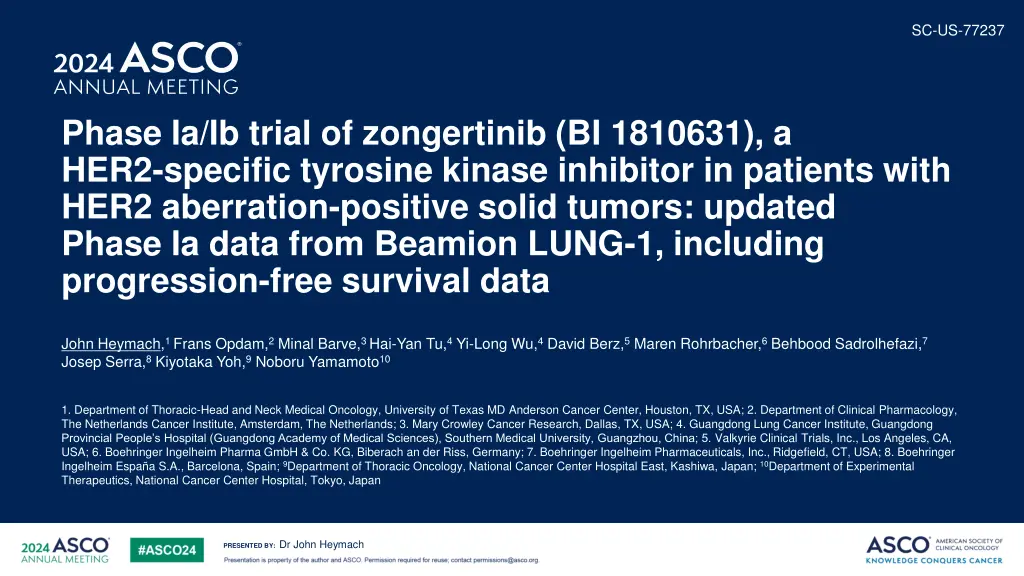
Zongertinib (BI.1810631) Phase I Clinical Trial Update for HER2-Positive Solid Tumors
Explore the latest data from the Phase I trial of zongertinib (BI.1810631), a HER2-specific tyrosine kinase inhibitor, in patients with HER2 aberration-positive solid tumors. Learn about the trial design, endpoints, dosing strategies, and key inclusion criteria for different cohorts. Stay informed about the interim futility analysis, primary and secondary endpoints, and patient populations being targeted. Follow the progress in investigating zongertinib as a potential oral treatment for NSCLC tumors harboring HER2 TKD mutations, including exon 20 insertions.
Download Presentation

Please find below an Image/Link to download the presentation.
The content on the website is provided AS IS for your information and personal use only. It may not be sold, licensed, or shared on other websites without obtaining consent from the author. If you encounter any issues during the download, it is possible that the publisher has removed the file from their server.
You are allowed to download the files provided on this website for personal or commercial use, subject to the condition that they are used lawfully. All files are the property of their respective owners.
The content on the website is provided AS IS for your information and personal use only. It may not be sold, licensed, or shared on other websites without obtaining consent from the author.
E N D
Presentation Transcript
SC-US-77237 Phase Ia/Ib trial of zongertinib (BI 1810631), a HER2-specific tyrosine kinase inhibitor in patients with HER2 aberration-positive solid tumors: updated Phase Ia data from Beamion LUNG-1, including progression-free survival data John Heymach,1 Frans Opdam,2Minal Barve,3 Hai-Yan Tu,4Yi-Long Wu,4David Berz,5Maren Rohrbacher,6Behbood Sadrolhefazi,7 Josep Serra,8Kiyotaka Yoh,9Noboru Yamamoto10 1. Department of Thoracic-Head and Neck Medical Oncology, University of Texas MD Anderson Cancer Center, Houston, TX, USA; 2. Department of Clinical Pharmacology, The Netherlands Cancer Institute, Amsterdam, The Netherlands; 3. Mary Crowley Cancer Research, Dallas, TX, USA; 4. Guangdong Lung Cancer Institute, Guangdong Provincial People s Hospital (Guangdong Academy of Medical Sciences), Southern Medical University, Guangzhou, China; 5. Valkyrie Clinical Trials, Inc., Los Angeles, CA, USA; 6. Boehringer Ingelheim Pharma GmbH & Co. KG, Biberach an der Riss, Germany; 7. Boehringer Ingelheim Pharmaceuticals, Inc., Ridgefield, CT, USA; 8. Boehringer Ingelheim Espa a S.A., Barcelona, Spain; 9Department of Thoracic Oncology, National Cancer Center Hospital East, Kashiwa, Japan; 10Department of Experimental Therapeutics, National Cancer Center Hospital, Tokyo, Japan Dr John Heymach PRESENTED BY:
2 Beamion LUNG-1 (NCT04886804): trial design/endpoints Zongertinib (BI 1810631) is a novel TKI that covalently and selectively binds to the TKD of HER2, and is under investigation as an oral treatment for NSCLC tumors harboring HER2 TKD mutations, including ex20ins mutations Phase Ib: ongoing dose expansion (in patients with HER2 mutation-positive NSCLC) Cohort 1* Phase Ia: dose escalation (in patients with advanced solid tumors with HER2aberrations) Cohort 1 360 mg 150 mg Interim futility analysis 300 mg n=~30 Cohort 2 Cohort 5 Cohort 2 n=~36 100 mg 240 mg 60 mg 180 mg Cohort 5 30 mg 120 mg Cohort 3 (exploratory) Cohort 4 (exploratory) 15 mg 60 mg One oral dose, QD, 3-week cycles One oral dose, BID, 3-week cycles Phase Ib primary endpoint Phase Ia endpoints Pre-treated NSCLC with a HER2 TKD mutation Cohort 1: Primary: MTD and DLTs Further: preliminary efficacy (ORR) Key inclusion criteria ORR Treatment-na ve NSCLC with a HER2 TKD mutation Cohort 2: Key inclusion criteria NSCLC with a non-TKD HER2 mutation or HER2 TKD mutation-positive squamous NSCLC, pre-treated Cohort 3: HER2 aberration: overexpression, amplification, somatic mutation, or gene rearrangement involving HER2 or NRG1 Patients with HER2 mutation-positive NSCLC NSCLC with active brain metastases with a HER2 TKD mutation Cohort 4: Received 1 line of platinum-based combination chemotherapy (Cohorts 1, 3, 5) Cohort 5: NSCLC with a HER2 TKD mutation and prior treatment with HER2 directed ADCs Exhausted or not suitable for existing standard treatment options *Randomized to receive either 120 mg or 240 mg QD. One dose will be selected after interim analysis; RECIST v1.1; Excluding patients treated with ADCs ADC, antibody-drug conjugate; BID, twice daily; DLTs, dose-limiting toxicities; ex20ins, exon 20 insertion; HER2, human epidermal growth factor receptor 2; MTD, maximum tolerated dose; NRG1, neuregulin 1; NSCLC, non-small cell lung cancer; ORR, objective response rate; QD, once daily; RECIST v1.1, Response Evaluation Criteria in Solid Tumours version 1.1; TKD, tyrosine kinase domain; TKI, tyrosine kinase inhibitor Dr John Heymach PRESENTED BY:
3 Phase Ia: baseline characteristics Characteristic Total (N=83) Characteristic Total (N=83) 59.0 (31 81) 38 (45.8) Median age, years (range) Male, n (%) Race, n (%) Asian White Missing ECOG PS, n (%) 0 1 Previous lines of therapy, n (%) Diagnosis, n (%) NSCLC 43 (51.8) Breast cancer 9 (10.8) 39 (47.0) 35 (42.2) 9 (10.8) Colorectal cancer 7 (8.4) Esophageal cancer 5 (6.0) Other tumors* 15 (18.1) Unknown 4 (4.8) 31 (37.3) 52 (62.7) HER2 aberration, n/N tested (%) Mutation 42/75 (56.0) Amplification 9/11 (81.8) 32 (38.6) 47 (56.6) 4 (4.8) 2 Overexpression 24/28 (85.7) >2 Missing Rearrangement involving HER2 or NRG1 12/75 (16.0) Data cut-off: January 29, 2024. *Cervical (n=3), endometrial (n=3), gastrointestinal tract (n=2), genitourinary system (n=1), small intestine, (n=1), biliary tract (n=1), mediastinum (n=1), pancreas (n=1), vulva (1), and other (n=1); Tumor type was not listed for four patients; 1+, 2+, or 3+ on immunohistochemistry ECOG PS, Eastern Cooperative Oncology Group performance status; HER2, human epidermal growth factor receptor 2; NRG1, neuregulin 1; NSCLC, non-small cell lung cancer Dr John Heymach PRESENTED BY:
4 Phase Ia: antitumor response across all dose levels* Best confirmed tumor response Best change from baseline in target lesions (%) Esophagus ORR Overall DCR 60 35% 85% Esophagus Biliary tract (N=74) 40 Breast Breast Colorectal Cervix NSCLC 20 ORR DCR 44% 93% (N=41) 0 -20 Unconfirmed response rates -40 Prior trastuzumab ORR DCR 36% 79% deruxtecan -60 Non-lung (n=14) Breast Vulva Lung Unknown -80 Cervix Breast Prior HER2 tx ORR DCR 38% 84% GI tract (n=32) -100 Data cut-off: January 29, 2024.*Responses are restricted to non-CNS lesions by RECIST 1.1. Prior treatment with other HER2 therapies was permitted CNS, central nervous system; DCR, disease control rate; GI, gastrointestinal; HER2, human epidermal growth factor receptor 2; NSCLC, non-small cell lung cancer; ORR, objective response rate; tx, treatment Dr John Heymach PRESENTED BY:
5 Phase Ia: antitumor response by HER2 mutation status* Mutation type (evaluable for response) ORR, n (%) DCR, n (%) Any HER2 (n=41) 23 (56.0) 38 (93.0) HER2 TKD (n=34) 21 (62.0) 32 (94.0) A775_G776insYVMA (n=16) 11 (69.0) 15 (94.0) Data cut-off: January 29, 2024. *Responses are restricted to non-CNS lesions by RECIST 1.1. Patients with 1 post-baseline tumor assessment or discontinued before first assessment for any reason. Unconfirmed CNS, central nervous system; DCR, disease control rate; HER2, human epidermal growth factor receptor 2; ORR, objective response rate; TKD, tyrosine kinase domain. Dr John Heymach PRESENTED BY:
6 Duration of treatment in Phase Ia* 45.8% Non-lung Patients still on treatment at data cut-off Lung Unknown SD PR PD Ongoing (n=26) 12.7 months (95% CI: 5.6 15.8) Median duration of response: overall 15.8 months (95% CI: 5.6 15.8) Median duration of response: NSCLC Days since treatment start 0 70 140 210 280 350 420 490 560 630 700 Data cut off: January 29, 2024. *Responses are restricted to non-CNS lesions by RECIST 1.1 CI, confidence interval; CNS, central nervous system; NSCLC, non-small cell lung cancer; PD, progressive disease; PR, partial response; SD, stable disease Dr John Heymach PRESENTED BY:
7 Phase Ia: PFS in patients with NSCLC* Data cut-off: January 29, 2024 BID, twice daily; CI, confidence interval; n.c., not reached; NSCLC, non-small cell lung cancer; PFS, progression-free survival; QD, once daily Dr John Heymach PRESENTED BY:
8 Phase Ia dose escalation and safety Total (N=83) Dose-limiting toxicities TRAEs (%) All grades 75.9 42.2 12.0 9.6 8.4 8.4 8.4 8.4 7.2 7.2 6.0 6.0 G 3 9.6 1.2 0.0 0.0 3.6 0.0 1.2 0.0 0.0 0.0 0.0 0.0 60 mg BID 150 mg BID 180 mg QD G2 edema G2 diarrhea G2 elevated AST and elevated bilirubin G3 elevated ALT G3 diarrhea (MTD period) G4 thrombocytopenia G4 neutropenia (MTD period) G4 hypokalemia G3 decreased platelet count (MTD period) Any TRAE* Diarrhea Rash Decreased appetite ALT increased Anemia AST increased Fatigue Dysgeusia Paronychia Dry skin Nausea 240 mg QD 300 mg QD 360 mg QD Only one grade 4 TRAE (thrombocytopenia; 240 mg) No grade 5 TRAEs MTD was not reached with either BID or QD schedule Doses taken to optimization: 120/240 mg QD Data cut-off: January 29, 2024. *TRAEs that occurred in 5 patients are listed; Combined term, includes rash, rash maculo-papular, dermatitis acneiform ALT, alanine aminotransferase; AST, aspartate aminotransferase; BID, twice daily; G, grade; MTD, maximum tolerated dose; QD, once daily; TRAEs, treatment-related adverse events Dr John Heymach PRESENTED BY:

